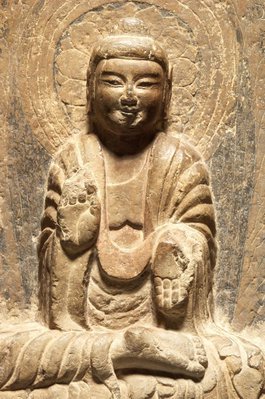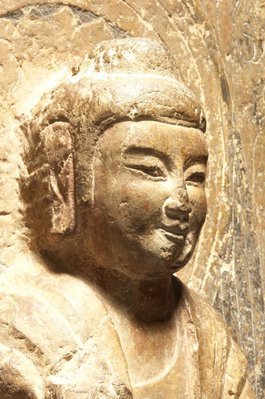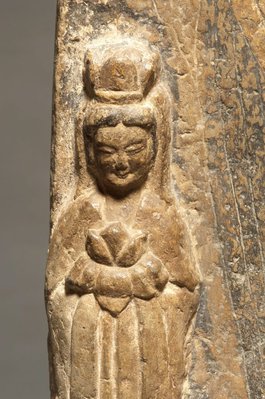






-
Details
- Other Title
- Buddhist stele with Buddha and two Bodhisattvas
- Place where the work was made
-
China
- Period
- Northern Wei 386 - 535 → Northern dynasties 420 - 589 → China
- Date
- 6th century
- Media category
- Sculpture
- Materials used
- limestone with traces of pigment
- Dimensions
- 76.0 x 38.2 x 13.0 cm
- Signature & date
Not signed. Not dated.
- Credit
- Purchased with funds provided by the Art Gallery of New South Wales Foundation, the Mary Eugene Tancred Bequest Fund, Jim & Janette Bain, Nick Curtis, Rowena Danziger AM & Ken Coles AM, Chum & Belinda Darvall and Isaac & Susan Wakil 2006
- Location
- Not on display
- Accession number
- 314.2006
- Copyright
- Share
-
-
About
The leaf shaped stele is carved on the front with Buddha seated with hands in 'abhaya' and 'varada mudra'. The figure is dressed in a voluminous robe falling in thick folds over the shoulder and arms and cascading down the base in undulating pleats - a characteristic feature of Chinese Buddhist sculpture of the Northern Wei period. The figure's full face, with a smiling contemplative expression, however suggests a later date, circa late Northern Wei or early Eastern Wei period. The Buddha is flanked by a pair of Bodhisattvas, each wears loose robes, a crown, and holds a lotus to the chest.
The group is backed by a 'mandorla' composed of incised parallel lines with a halo of overlapping petals enclosed by concentric circles behind the head. The reverse of the stele is incised with a similar group of a central seated figure of Buddha, flanked by a pair of Bodhisattvas, each on a lotus pedestal, bearing a lotus, in a setting of trees and mountains. The surface of the stone is smooth with traces of red and black pigments. The other two sides of the stele are incised with names and titles of donors, including two monks, two nuns and two laymen on the left, and two lay disciples on the right.
In China, it was during the Northern Wei period that Buddhist stele emerged as an important sculptural medium, being linked to the 'devotees' future life through personal devotion or accumulation of merits. This stele is a very fine example of the activity. Beside its excellent figurative configuration and carving, the inscription, though lacking a precise date, provides much information on its past function and significance. It would appear that in this case, the stele was raised by donors of a collective group, including Buddhist monks, nuns and lay disciples from a Buddhist devotional 'yi' society. The fine carving on the reverse suggests that the stele was once placed on main roads and other public places, or in a free-standing situation within a cave or temple, serving the purposes of adoration.
Asian Art Department, AGNSW, 2006.
-
Places
Where the work was made
China
-
Exhibition history
Shown in 5 exhibitions
Ancient Chinese Bronzes and Sculpture, New York, Eskenazi Ltd Oriental Art, London, Mar 2005 -
One hundred flowers (2011), Art Gallery of New South Wales, Sydney, 01 Sep 2011–15 Jan 2012
Conversations through the Asian collections, Art Gallery of New South Wales, Sydney, 25 Oct 2014–13 Mar 2016
Walking with gods, Art Gallery of New South Wales, Sydney, 01 Jun 2019–05 Jan 2020
Auspicious: Motifs in Chinese art, Chau Chak Wing Museum, University of Sydney, Sydney, 16 Nov 2020–15 May 2022
-
Bibliography
Referenced in 6 publications
-
Art Gallery of New South Wales, Art Gallery of New South Wales annual report 2007, Sydney, 2007, 24 (colour illus.).
-
Edmund Capon, Look, 'A stele from China', pg. 13, Sydney, Apr 2007, 13 (colour illus.).
-
Eskenazi (Editor), Ancient Chinese Bronzes and Sculpture, New York, Mar 2005, illus.. no. 11
-
Giuseppe Eskenazi, A dealer's hand. The Chinese art world through the eyes of Giuseppe Eskenazi, London, 2012, 218 (colour illus.). pl. 106
-
Saburo Matsubara, A History of Chinese Buddhist Sculpture, 1995, illus.. pl. 197b
-
Mitsuru Tajima (Editor), Chinese Stone and Gilt Bronze Sculpture, Tokyo, 28 Nov 1988, illus.. no. 4
-
-
Provenance
Private Collection, 1988, Tokyo/Japan, published in Mitsuru Tajima, 'Chinese stone and gilt bronze sculpture', Tokyo, 1988, no. 4.
Private Collection, 1995, Tokyo/Japan, published in Saburo Matsubara, 'A history of Chinese Buddhist sculpture', Tokyo 1995, plate 197b.
Private Collection, Mar 2005-Sep 2006, Tokyo/Japan, published in Eskenazi, 'Ancient Chinese bronzes and sculpture', New York, Mar 2005, no. 11. Purchased by the Art Gallery of New South Wales, Sydney, Sep 2006.
